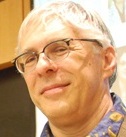7.11: Mutations, Deletions, Duplications & Repair
- Page ID
- 4708
While DNA is used as the universal genetic material of organisms, it is worth remembering that it is a thermodynamically unstable molecule. Eventually it will decompose into simpler (more stable) components. For example, at a temperature of ~13ºC, half of the phosphodiester bonds in a DNA sample will break after ~520 years214. But there is more. For example, cytosine can react with water, which is present at a concentration of ~54 M inside a cell. This leads to a deamination reaction that transforms cytosine into uracil. If left unrepaired the original CG base pair will be replaced by an AU base pair. But, uracil is not normally found in DNA and its presence will be recognized by an enzyme that severs the bond between the uracil moiety and the deoxyribose group215. The absence of a base, due either to spontaneous loss or enzymatic removal, acts as a signal for another enzyme system (the Base Excision Repair complex) that removes a section of the DNA strand with the missing base216. A DNA-dependent DNA polymerase binds to the open DNA and uses the existing strand as a primer and the undamaged strand as a template to fill in the gap. Finally, another enzyme (a DNA ligase) joins the newly synthesized segment to the pre-existing strand. In the human genome there are over 130 genes devoted to repairing damaged DNA217. Other hydrolysis reactions (depurination: the loss of an cytosine or thymine group and depyrimidination: the loss of an adenine or guanine group) lead to the removal of a base from the DNA. The rates of these reactions increases at acidic pH, which is probably one reason that the cytoplasm is not acidic. How frequent are such events? A human body contains ~1014 cells. Each cell contains about ~109 base pairs of DNA. Each cell (whether it is dividing or not) undergoes ~10,000 base loss events per day or ~1018 events per day per person. That's a lot! The basic instability of DNA (and the lack of repair after an organism dies) means that DNA from dinosaurs (the last of which went extinct ~65,000,000 years ago) has disappeared from the earth, makingit impossible to clone (or resurrect) a true dinosaur218. In additionDNA can be damaged by environmental factors, such as radiation, ingested chemicals, and reactive compounds made by the cell itself. Many of the most potent known mutagens are natural products, often produced by organisms to defend themselves against being eaten or infected by parasites, predators, or pathogens219.
References
- Here is the paper from which statement is derived: http://www.nature.com/news/dna-has-a...f-life-1.11555
- uracil-DNA-N-glycosidase
- absent purine/absent pyrimidine endonuclease http://omim.org/entry/300773
- Human DNA Repair Genes: http://www.sciencemag.org/content/291/5507/1284.full. video with lots of misspelled words:http://youtu.be/g4khROaOO6c
- DNA has a 521-year half-life: http://www.nature.com/news/dna-has-a...f-life-1.11555
- Dietary carcinogens, environmental pollution, and cancer: some misconception: http://link.springer.com/article/10.1007/BF02988534
Contributors and Attributions
Michael W. Klymkowsky (University of Colorado Boulder) and Melanie M. Cooper (Michigan State University) with significant contributions by Emina Begovic & some editorial assistance of Rebecca Klymkowsky.


